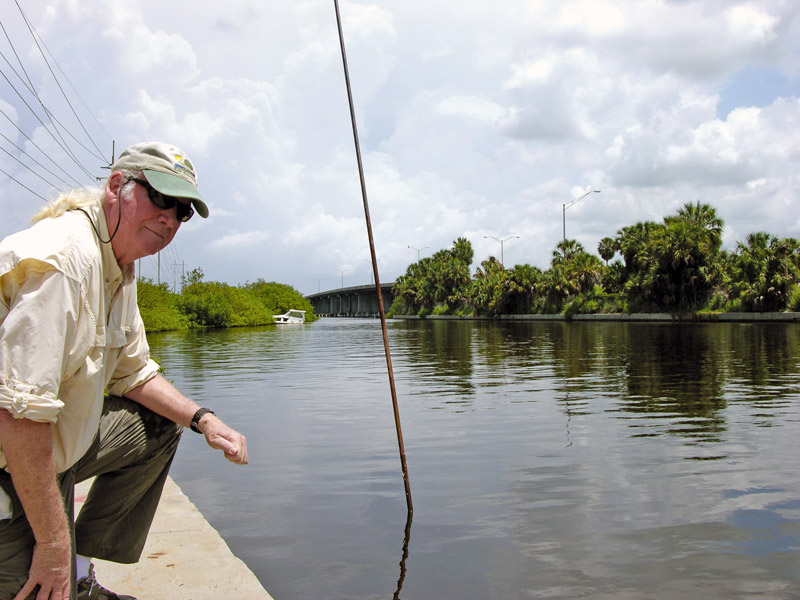
Roy Lewis III, president of Riverview’s Lewis Environmental Services, designed the $4.5-million restoration project. Kevin Brady Photo
By KEVIN BRADY
Almost a decade in the making, a massive wetland restoration program is about to get underway in Gibsonton. The $4.5-million project includes restoring mangroves at two plots along U.S. Highway 41 and is expected to take about a year to complete.
Work on 10 acres of mangroves restoration and new oyster reefs, part one of the project, starts next month at Giant’s Camp, a stone’s throw from the Alafia River Bridge on U.S. Highway 41. Part two, a similar project just north of the Giant’s Camp on U.S. 41, will begin in the fall.
Construction manager John Landon doesn’t foresee any problems for drivers in the area.
“We don’t anticipate any impacts on U.S. 41,” Landon said. “You will probably see work at the site from the road for a couple of months but after that the dredge goes in and I don’t think you will even be able to see that from the road once it starts.”
Mosiac, the world’s largest phosphate company, is footing the bill for the project as part of a compensation package the firm agreed with the federal government after a dike at its Riverview plant broke and contaminated local waters in 2004.
“When something like that happens you have a responsibility as a company to develop environmental projects,” said David Townsend, an assistant vice president at Mosaic.
Heavy rains from Hurricane Frances that year broke the back of the company’s dike, sending 60,000 gallons of contaminated water into Archie Creek, which flows in to Tampa Bay, killing vegetation and fish.
Mosaic has since spent $30 million to improve water-storage capacity at the Riverview fertilizer plant. “We can now handle up to 80 inches of rain,” Townsend said.
One of the largest agro-chemical companies in the world with mines in Central Florida and North Carolina, Mosaic provides fertilizer to farmers in 40 countries. Most of the fertilizer used in the U.S. comes from Florida phosphate mines, much of it mined by Mosaic in Polk County.
Work at Giant’s Camp starts July 13 and is expected to be completed in early 2014.
The project includes digging a 1,500-foot long, 50-foot wide channel through the mangrove habitat, breathing new life into the mangroves, which are currently cut off from any real tidal flow. A marina, built in the 1950s but since abandoned, all but cut the mangroves from any tidal flow.
Tidal flows are the lungs of mangroves; without it the plants grow in on each other eventually leading to a ‘mangrove heart attack’ where mangroves die and turn into mudflats. One acre of the property, clearly visible from overhead photos, has already turned into a mudflat.
So why spend $4.5 million restoring the area?
“Mangroves are the heartbeat of Tampa Bay,” said Roy Lewis III, president of Lewis Environmental Services, the Riverview company that designed the restoration project. “It’s where juvenile fish hang out and mature and move into the bay. Tampa Bay has lost 40 percent of its mangroves over the last 100 years and as a direct result, commercial and recreational fishing have declined.”
The restoration project will bring new life to the mangroves, securing their future for hundreds of years, Lewis said.
“When it’s done there will be four tides a day flushing through the property and when the tide is ripping you will see a significant amount of fish coming through,” Lewis said.
“More fish in the water would be an awesome thing, not even for my place but in general,” said Lisa Cremeans, owner of the River’s Edge Lounge, a quarter-mile from the Giant’s Camp.
Popular with boaters and fishermen, the lounge is near a major boat ramp for the Alafia River.
Cremeans believes the project will be popular with the locals. “I think they would be happy to know there would be more fishing.”
Reopening the mangroves to the natural flow of the tide will also involve dredging a 1,000-foot long, 5-foot deep channel in the existing waterway, bringing a healthy flow of water into the area.
Engineers will also build a bridge over the new channel once they cut through the old marina wall to reopen the mangroves.
While the tides will breathe new life into the mangroves, new oyster beds, also part of the restoration project, will help clean that water before it enters the area.
Just one oyster can filter 50 gallons of water a day, removing excess nutrients, bacteria and organic matter, improving overall water quality. Oyster reefs also serve as feeding grounds for wading birds and game fish such as snapper, grouper and snook.
Some 5,650 square feet of rock will be used in the project for oyster beds.
Support structures for the bridge will be built first, with dredging slated for later this summer.
Construction of the bridge over the inlet channel comes during the final phase of construction.
The project will also see exotic, non-native plants removed from two acres along the site at Lula Road.
Mangrove restoration isn’t the only local environmental project Mosaic is backing.
The company, which is seeking federal permission for new mines in Florida, last year donated $225,000 to Tampa Bay Watch, a nonprofit group dedicated to protecting and restoring the Bay area’s marine and wetland ecosystem.
The donation, the largest in the group’s 20-year history, is being used to build an oyster reef on Green Key, just 1.5 miles south of the Giant’s Camp between Gibsonton and Apollo Beach.

